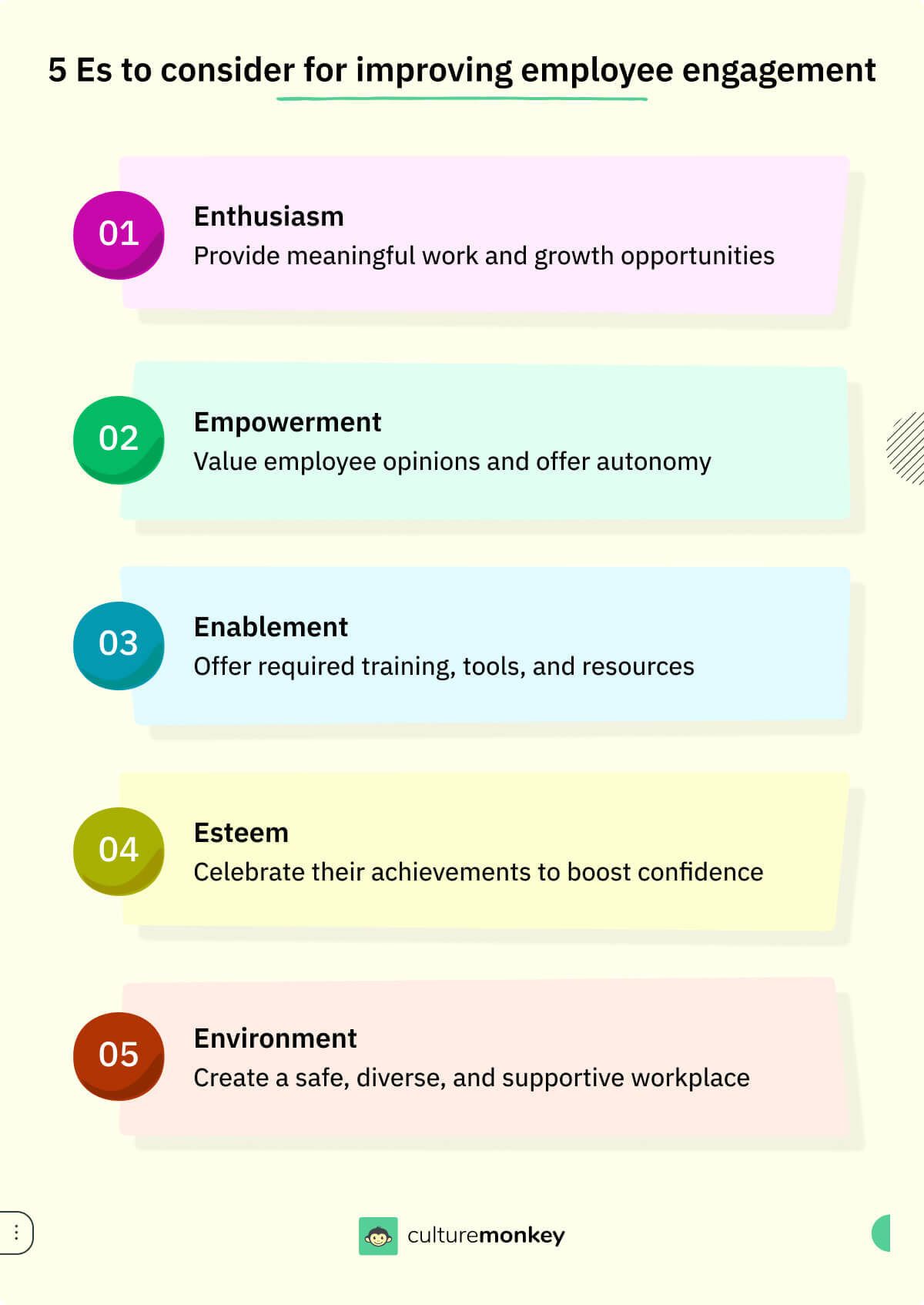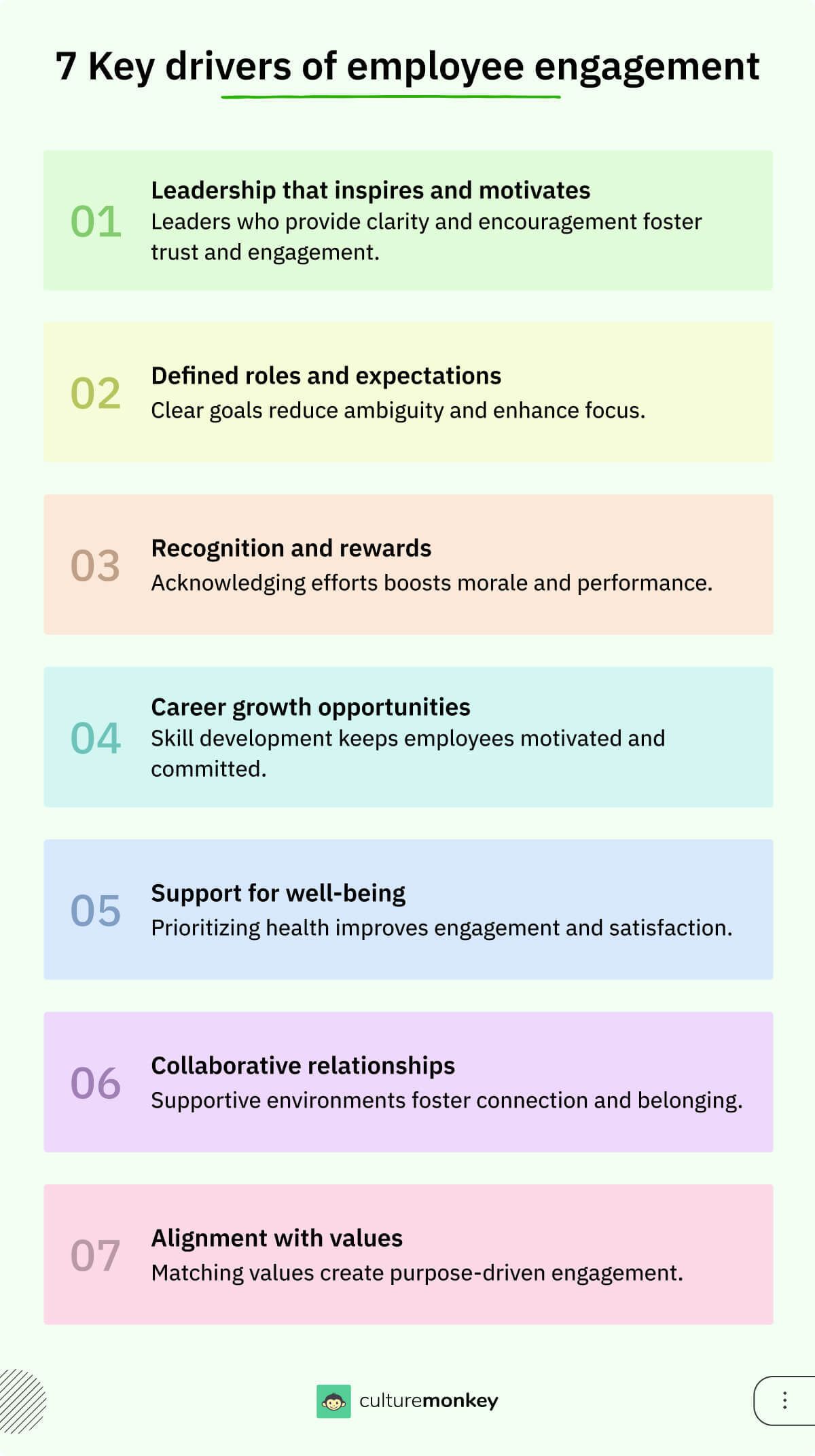What are the types of engaged employees and the elements that help boost workplace?

Imagine a symphony where every instrument plays in perfect harmony, creating music that captivates the soul. In the workplace, the instruments are employees, and their engagement levels determine the melody. Understanding the types of engaged employees and the elements that foster workplace engagement is key to orchestrating a thriving work culture.
Understanding the employees engagement levels and the elements that foster workplace engagement is crucial for building a productive and positive work environment. By identifying different engagement levels—actively engaged, not engaged, and actively disengaged—organizations can tailor strategies to address specific needs.
Encouraging open communication, providing opportunities for professional growth, and aligning employees’ roles with organizational goals are essential for creating a workplace where employees feel valued, motivated, and empowered to contribute to the company’s success.
Blog Highlights


What is employee engagement?

Employee engagement is a critical element for any business’s success. It involves creating an environment where employees are enthusiastic about their job, motivated to do their best, and willing to go the extra mile. When employees are engaged, they are more productive and have higher job satisfaction.
This leads to employee engagement, lower employee turnover, better customer service, and increased loyalty to the organization. It is a hot topic around the world for many reasons and has been proven to be a key factor in a business's success, as it affects employees' productivity, morale, and overall work satisfaction.
It also helps to create a positive corporate culture by providing a sense of purpose and belonging; employees are more likely to be engaged and motivated to do their best. A positive workplace culture can also attract and retain top talent and help create a more productive work environment.
Companies are increasingly realizing the importance of engaging with their employees and are actively looking for ways to do so. They are also realizing the positive impact that employee engagement can have on their business and are taking steps to ensure that engaged employees are motivated.
3 Types of employee engagement
Employee engagement is the level of commitment and energy an employee brings to their work. It is a fundamental element in creating a successful and productive workplace.
It's not only important to improve employee engagement levels for business success but also for the well-being of employees.
There are three major needs to drive employee engagement, and each need has its unique benefits and challenges, and it is important to understand them all to ensure your employees are engaged.
1. Cognitive engagement
Cognitive engagement is necessary for organizations to stay competitive in the ever-changing business environment. It helps to create an environment of continuous learning, which helps employees to become more knowledgeable and productive.
It encourages employees to develop their skills, which can lead to improved workplace satisfaction, better job performance, and retention.
Cognitive engagement is also important for team engagement, collaboration, and communication. By creating an environment where employees are encouraged to think critically and work together, organizations can develop an effective team culture that can lead to better performance.
2. Physical engagement
Physical engagement in the workplace is essential for employee engagement and employees to stay active and productive. It has been proven to reduce stress levels, improve overall health, and even increase concentration and memory.
It can come in many forms, from stretching and taking a quick walk or jog, to having an office exercise session, and it also helps to promote team bonding and collaboration.
Engaging in physical activities together encourages employees to work together and build trust. This can lead to improved internal communication skills and better overall performance.
Physical engagement also helps to break up the monotony of the workday and make it more enjoyable. It can also be a great way to reward employees for their hard work and dedication.
3. Emotional engagement
Emotional engagement in the workplace is important for many reasons. It creates a positive working environment, increases morale and productivity, and helps foster strong relationships between employees to boost employee engagement.
When employees are emotionally engaged in their work, they feel connected to the company’s vision and goals, making them more likely to have a positive attitude and higher productivity.
Emotional connection in the workplace also helps to create a sense of team spirit and camaraderie. Employees who feel connected to each other can work better together and form a strong bond that can help to increase collaboration and innovation.
This is because when employees perceive that they are valued and appreciated, they are more willing to put in extra effort to reach the company’s objectives.
4 Levels of employee engagement

A comprehensive way to evaluate engagement among employees is to focus on their attitudes and performance level through the types of employee engagement.
There are 3 primary types of employee engagement that allow people leaders and managers to evaluate engagement in the workplace.
By assessing the types of employee engagement, employers can better understand the overall performance levels and engagement of their employees and take steps to ensure that each individual feels connected and engaged with their job responsibilities.
1. Actively disengaged employees
Actively disengaged employees are those who are unhappy at work and actively undermine the organization's efforts.
This group of employees is characterized by negative attitudes, low productivity, and a lack of engagement with their job. They can have a significant impact on the overall performance of an organization's values.
People leaders should take active steps to address the issue of actively disengaged employees. The first step is to identify the root cause of the disengagement. This could be due to any number of factors including a lack of job satisfaction, poor management, or a lack of recognition. Once the root cause is identified, the people leaders should work to address the issue.
This could include creating a more positive work environment, offering more meaningful rewards, investing in training and development opportunities, and providing better communication and feedback.
It is also important for people leaders to ensure that actively disengaged employees are not allowed to impact other employees negatively, which can be done by providing ongoing coaching and feedback and creating an open and positive work culture.
Taking action to address the issue of actively disengaged employees is essential in order to ensure that the organization is able to maintain a positive and productive environment.
2. Moderately engaged employees
Moderately engaged employees fall in between actively engaged and not engaged employees. They complete their tasks efficiently and meet expectations but lack the enthusiasm and passion seen in highly engaged employees.
These employees may show signs of satisfaction with their roles but do not actively contribute beyond their basic responsibilities.
People leaders should identify ways to transition moderately engaged employees into actively engaged ones. This can be achieved by providing opportunities for professional growth, such as training programs or career development initiatives, to rekindle their interest in the organization.
Leaders should also focus on building stronger connections with these employees by encouraging open dialogue about their career aspirations and aligning their roles with their strengths and interests. Additionally, recognizing their contributions and involving them in decision-making processes can foster a sense of ownership and motivation.
By addressing the unique needs of moderately engaged employees, organizations can unlock their potential, driving higher engagement levels and overall performance.



Businesses often forget about the culture, and ultimately, they suffer for it because you can’t deliver good service from unhappy employees.
CEO
Zappos
3. Actively engaged employees
Actively engaged employees are an essential part of any successful business. They are the people who demonstrate their commitment to their work and the success of the company.
They have a positive attitude towards their job, are enthusiastic about making a positive difference, and are motivated to do their best and strive for excellence.
People leaders should take various measures to ensure their employees are actively engaged. One of the most important is to implement frequent anonymous feedback to boost employee engagement types.
This should include positive and constructive feedback and recognition for a well-done job. This encourages and motivates employees them to continue to put in their best effort.
Another measure that people leaders should take to ensure that their employees are engaged is to create a culture of open communication between themselves and the employees.
This should include regular meetings or forums where employees can discuss their ideas and concerns, which will help to create an environment where employees feel comfortable voicing their opinions and providing valuable feedback to management.
Also, providing training and development opportunities, offering flexible working arrangements, and investing in technology that will help employee engagement important types. When employees engaged in the workplace along with these measures can help boost worker engagement levels and create a more productive and take organization forward.
People leaders should take measures to ensure that their actively engaged employee is motivated. This includes providing regular feedback, creating a workplace culture of open communication, and providing employees with the resources they need to do their best work.
4. Not engaged employees
Not engaged employees are those who are not emotionally connected to their work or organization. They are usually apathetic and lack enthusiasm when it comes to their job duties and may not put in the same effort as their colleagues, and may not be motivated to contribute to the high turnover organizations.
People leaders should focus on identifying the root cause of employee disengagement. It could be due to a lack of appreciation or recognition, feeling unvalued or underappreciated, or feeling disconnected from the organization’s goals and mission.
Once the cause has been identified, leaders should take active steps to improve the situation.
Some measures that people leaders should take to engage their employees to include:
- Providing regular feedback and recognition: Providing regular feedback and praise for a job well done. This helps employees feel appreciated and motivated to do their best.
- Encouraging collaboration: Creating an environment of collaboration and teamwork. When employees feel like they are part of a team, they are more likely to be engaged in their work.
- Creating a sense of purpose: People leaders should ensure that employees understand the importance of their work and its impact on the organization. They should also ensure that they are provided with opportunities for personal growth.
- Listening to employees: Listening to and taking their ideas and suggestions seriously will help employees feel valued and respected, leading to higher engagement levels.
By fostering a positive and engaging work environment, people leaders can ensure that their not engaged employee is motivated and productive.
What factors cause decline in employee engagement?

Employee engagement is a critical component of a productive and thriving workplace. However, maintaining high engagement levels can be challenging if certain issues persist. Understanding the factors that lead to a decline in employee engagement is essential for creating effective strategies to address them. Below are some overlooked yet impactful causes:
- Lack of career development opportunities : When employees cannot see a clear trajectory for growth within the organization, they often feel stagnant. This lack of direction dampens motivation and reduces engagement levels, which is a crucial element in the classification of employee engagement.
- Excessive micromanagement: Employees thrive in environments where they feel trusted. Constant oversight and micromanagement can erode confidence, discourage innovation, and lead to frustration, impacting the emotional engagement of employees.
- Inadequate workplace technology: Outdated or inefficient tools and systems can hinder employees’ ability to perform their duties effectively. This creates frustration, delays, and disengagement, disrupting the alignment of employee engagement with corporate components.
- Unaddressed workplace conflicts: Conflict among team members that remains unresolved fosters negativity, decreases morale, and disrupts collaboration, reducing overall levels of employee engagement.Lack of purpose alignment: If employees fail to see how their roles align with the organization’s purpose and mission, they may struggle to find meaning in their work. This absence of connection affects actively engaged employees and the overall effectiveness of an employee engagement framework.
What are the 5 E's of employee engagement?

Employee engagement isn't just a catchphrase; it's a game-changer for organizations looking to boost productivity and foster a positive work culture. And to achieve it, you need to remember the 5 E's of employee engagement.
- Enthusiasm: Engagement starts with enthusiasm. It's about employees waking up excited about the day ahead. Enthusiastic employees are more likely to go above and beyond, and their positivity is infectious. To cultivate enthusiasm, provide meaningful work and opportunities for growth.
- Empowerment: Engaged employees need to feel empowered. They want to know that their opinions matter and that they have a say in decisions that affect their work. Give them autonomy and trust in their abilities. When employees feel empowered, they take ownership of their roles.
- Enablement: You can't expect employees to excel if they don't have the tools and resources they need. Enablement means providing the right training, technology, and support. Invest in their development and ensure they have what it takes to succeed.
- Esteem: Esteem isn't just about recognition and rewards (although those are important). It's about making employees feel valued and appreciated. Recognize their contributions, celebrate achievements, and provide constructive feedback. When employees feel esteemed, their self-worth and engagement soar.
- Environment: The workplace environment plays a significant role in engagement. It's not just about physical space; it's also about the culture and atmosphere. Create an inclusive, diverse, and supportive environment where employees feel safe to be themselves and share their ideas.
The evolution of employee engagement

Early attempts at engagement included things like company picnics, employee recognition, and the provision of employee benefits.
In the late 20th century, a more scientific approach to employee engagement emerged as companies measured employee engagement levels using surveys and questionnaires. These surveys and questionnaires to engage employees, and were used to gauge overall satisfaction with their job. While this was effective to some extent, it was limited in its ability to measure true employee engagement types.
Today, organizations are taking a more comprehensive approach to employee engagement. They are using a variety of tools and strategies to measure employee engagement levels, such as pulse surveys, employee retention, employee experience platforms, and analytics tools.
By using these tools, organizations can track types of employee engagement based throughout the organization in real-time and make more informed decisions about improving employee engagement and driving productivity.
Currently, organizations are also taking a more holistic approach to employee engagement by looking at the whole employee experience, including factors such as good work-life balance, proper mental health, workplace satisfaction, work environment, and career development.
By viewing all the types of employee engagement based throughout, organizations can better identify areas of need and make changes that will drive greater performance.
The future: Technology and flexibility
Looking ahead, technology will play a pivotal role in shaping the future of employee engagement. With remote work becoming more prevalent, companies are leveraging employee engagement survey tools to keep their teams connected and engaged. Flexibility and adaptability will be key as the workforce continues to evolve.
10 Elements of employee engagement in the workplace

Ever wonder what makes employees truly engaged and excited about their jobs? Well, it's not just about showing up from 9 to 5; it's about diving into the heart of your work with passion and dedication. Let's explore the key elements of employee engagement that can transform your office into a hub of productivity and enthusiasm.
- Meaningful work: Imagine waking up every day knowing that your tasks have a real impact. Employees crave meaningful work – tasks that align with their values and contribute to a larger purpose. When what you do matters, engagement skyrockets.
- Effective leadership: Great leaders are the rudders that steer the ship. Employees need supportive and inspiring leaders who communicate clearly, set expectations, and provide regular feedback. When employees feel heard and valued, they're more likely to engage.
- Recognition and appreciation: Who doesn't like a pat on the back for a job well done? Recognition, whether it's a simple "thank you" or a formal award, boosts morale and fuels engagement. When employees feel appreciated, they're motivated to keep up the good work.
- Career development: Nobody wants to be stuck in a dead-end job. Organizations that invest in employee growth and development create a workforce that's not just engaged but also loyal. Providing opportunities for learning and advancement keeps employees engaged for the long haul.
- Work-life balance: Burnout is the enemy of engagement. Employees need a healthy work-life balance to stay engaged. Encourage breaks, time off, and flexibility to recharge and return to work with renewed energy.
- Collaborative environment: Engaged employees thrive in a collaborative atmosphere. Encourage teamwork, open communication, and a culture where diverse perspectives are valued. When employees feel part of a cohesive team, engagement soars.
- Health and well-being: A healthy body and mind are crucial for sustained engagement. Offer wellness programs, access to healthcare, and mental health support. When employees feel their well-being is a priority, they're more likely to stay engaged.
- Alignment with values: Employees want to work for organizations that align with their personal values. When an organization's mission and values resonate with employees, it fosters a sense of belonging and purpose, driving higher engagement.
- Trust and transparency: Trust is the foundation of engagement. Be transparent in decision-making processes and communicate openly. When employees trust their leaders and the organization, they're more likely to engage wholeheartedly.
- Feedback and surveys: Regular feedback loops through surveys and one-on-one discussions help organizations understand what's working and what needs improvement. It's a powerful tool to adapt and enhance the employee experience.
What is the physical environment at work?

The physical environment at work refers to the tangible aspects of a workplace that influence employee comfort, health, and productivity. It encompasses elements such as office layout, lighting, ventilation, ergonomic furniture, noise levels, and even access to outdoor spaces.
A well-designed physical environment can significantly enhance employee satisfaction and engagement. Factors like proper lighting and comfortable seating reduce fatigue, while quiet spaces encourage focus and efficiency. On the other hand, poorly designed environments with excessive noise or inadequate facilities can lead to stress and disengagement. Optimizing the physical environment is one of the key components of employee engagement, creating a productive and thriving workplace.
Strategies to improve physical engagement
Physical engagement is essential for employee well-being and productivity. Implementing thoughtful strategies can encourage employees to stay active, energized, and connected to their workplace.
- Flexible workspace design: Create a variety of spaces for different activities, such as standing desks, collaboration zones, and quiet areas. This allows employees to move and adjust their environment based on their tasks, promoting physical activity.
- Incorporate wellness programs: Offer programs like yoga sessions, on-site fitness classes, or access to local gyms. These initiatives encourage employees to prioritize their physical health and incorporate movement into their routines.
- Promote outdoor breaks: Encourage employees to take breaks outside, whether for a walk, fresh air, or outdoor meetings. This not only refreshes the mind but also boosts physical activity during the workday.
- Host active team-building activities: Replace traditional team meetings with active alternatives, such as walking meetings or group challenges. These activities foster collaboration while promoting physical engagement.
- Provide ergonomic tools and training: Invest in ergonomic furniture and educate employees on proper posture and movement techniques. This reduces physical strain, enhances comfort, and supports long-term physical health.
What is emotional engagement at work?

Emotional engagement at work refers to the deep connection employees feel with their roles, colleagues, and organization. It drives motivation, commitment, and a sense of purpose. Employees who are emotionally engaged exhibit characteristics of engaged employees, such as heightened creativity, loyalty, and productivity. This critical element of employee engagement fosters a thriving workplace culture and boosts organizational success.
Strategies to improve emotional engagement at work
Emotional engagement is essential for creating a motivated, resilient workforce. By fostering a strong connection between employees and their roles, organizations can enhance productivity and morale. Here are effective strategies to improve emotional engagement:
- Recognize individual contributions: Personalized recognition for achievements fosters a sense of value and belonging. Acknowledging efforts regularly can boost emotional connections with the organization.
- Promote meaningful work: Assign tasks that align with employees' skills and interests. When employees find meaning in their work, they become more emotionally invested in their roles.
- Cultivate a supportive leadership culture: Train leaders to build genuine relationships with their teams. Empathetic leadership helps employees feel understood and supported, enhancing emotional engagement.
- Encourage peer-to-peer connections: Facilitate team-building activities and collaboration opportunities. Strong workplace relationships promote trust and emotional well-being.
- Provide mental health resources: Offer counseling services, stress management workshops, or mindfulness sessions. Addressing emotional needs ensures employees feel supported in all aspects of their well-being.
What is cognitive engagement at work?

Cognitive engagement at work refers to an employee's mental investment and focus on their tasks. It involves critical thinking, problem-solving, and being fully absorbed in work responsibilities. This type of engagement enhances creativity, productivity, and job satisfaction. Cognitive engagement is a key element of employee engagement, driving innovation and ensuring employees contribute meaningfully to organizational success.
Strategies to improve cognitive engagement at work
Cognitive engagement is vital for fostering creativity, focus, and problem-solving in the workplace. By adopting strategies to enhance employees’ mental investment, organizations can build a culture of productivity and innovation. Here are actionable steps to improve cognitive engagement:
- Set clear performance expectations: Define roles and responsibilities with precision. Clear expectations help employees focus on their tasks without ambiguity, fostering cognitive engagement.
- Encourage ownership of tasks: Allow employees to take responsibility for projects. Empowering them to make decisions enhances their mental investment and commitment to delivering quality outcomes.
- Create a distraction-free workspace: Design work environments that minimize interruptions. Quiet zones or tools to block noise can improve concentration and cognitive performance.
- Incorporate problem-solving challenges: Offer opportunities like hackathons or brainstorming sessions. These challenges stimulate critical thinking and promote deeper cognitive involvement.
- Leverage technology for task management: Use digital tools to streamline workflows and reduce administrative burdens. Efficient systems allow employees to focus on creative and strategic tasks, boosting engagement.
What are the models of employee engagement?

Different companies may have divergent approaches to surveys and strategies, yet these three models are the most commonly used frameworks to comprehend employee engagement.
Each model has its own distinctive way of tackling employee engagement, but all of them offer something valuable to learn from. You can select the model that best fits your organization, or combine the best practices from different entities when creating your employee engagement strategy.
The Zinger Model
The Zinger Model is a dynamic framework developed to help organizations create and sustain change. It is a process-oriented approach to organizational change that focuses on developing integrated systems, processes, and structures that support the desired change.
It emphasizes the need for clear objectives, strategy development, and measurement and encourages organizations to identify and engage stakeholders, build collaboration structures, and develop effective communication strategies.
This holistic approach to organizational change combines both tactical and strategic elements and helps organizations create and sustain meaningful change.
The AON Hewitt Engagement Model
The AON Hewitt Model is a strategic planning framework that helps organizations identify and define a set of goals and objectives to better align their resources and capabilities with the organization's overall mission.
The model comprises four components: vision, strategy, capability, and performance. The vision component helps organizations to clearly articulate the desired future state of their organization, while the strategy component allows organizations to determine the best way to achieve their desired goals.
The capability component helps organizations to assess their current capabilities and identify areas for improvement, while the performance component helps organizations track their progress in meeting their desired goals.
Through the use of the AON Hewitt Model, organizations can better align their resources and capabilities to their overall mission, leading to improved organizational success.



An employee’s job is to give his or her best work every day. A manager’s job is to give the employee a good reason to come back to work tomorrow.
CEO and founder
The Deloitte Model
The Deloitte Model is a comprehensive system that encourages businesses to align their activities, resources, and investments with their strategic objectives.
It emphasizes the importance of four components: strategy, organization, people, and technology. Through this approach, organizations can strive to achieve their business goals while keeping up with their corporate responsibility.
The model also encourages to think proactively, evaluate their progress, and adjust their strategies accordingly. By focusing on these four components, companies can ensure they have the capability to reach their goals while taking into account their environmental and societal impacts.
The Gallup Model
The Gallup Model is all about understanding and leveraging the strengths and talents of employees. It emphasizes the importance of identifying and nurturing these strengths to drive engagement.
This model is built around the concept of the strengths-based approach, which involves assessing employees' natural talents, developing those talents into strengths, and aligning these strengths with their roles and responsibilities. When employees are working in roles that play to their strengths, they tend to be more engaged, productive, and satisfied.
By focusing on employee strengths, organizations can create a workplace where individuals are encouraged to do what they do best every day, resulting in higher engagement levels and improved overall performance.
The Maslach and Leiter Model
The Maslach and Leiter Model, also known as the Burnout Model, revolves around the concept of preventing employee burnout. It identifies three components of burnout: emotional exhaustion, depersonalization, and reduced personal accomplishment.
This model encourages organizations to address these components proactively. By taking steps to reduce emotional exhaustion, foster a sense of personal accomplishment, and promote genuine, positive relationships with colleagues and clients, organizations can prevent burnout and create a more engaged and satisfied workforce.
Incorporating the Maslach and Leiter Model into your engagement strategy can help in recognizing the signs of burnout early and implementing employee engagement strategies to mitigate it. By doing so, organizations can maintain a workforce that is not just engaged but also mentally and emotionally healthy.
The Kahn Model
The Kahn Model, developed by William A. Kahn, focuses on the psychological conditions necessary for employees to fully engage in their work. It posits that employee engagement goes beyond the fulfillment of basic job requirements and includes a sense of meaningful connection and emotional attachment to the organization.
This model suggests that employees need to experience three psychological conditions for engagement: meaningfulness (the sense that their work is valuable), safety (feeling secure in their role and relationships), and availability (willingness to invest oneself in the work role).
Organizations that aim to boost engagement should foster these psychological conditions to create a workforce that is not just present but fully immersed in their roles.
What are the 7 drivers of employee engagement?

The seven drivers of employee engagement are like gears in a well-oiled machine. Each one plays a critical role in creating a workplace where employees are motivated, committed, and excited to contribute their best.
- Leadership: Leadership sets the tone for engagement. When leaders are inspiring, approachable, and provide clear direction, employees feel motivated and connected to the organization's vision.
- Clear expectations: Employees need to know what's expected of them. When roles and expectations are well-defined, employees can focus on their work without the stress of uncertainty.
- Recognition and rewards: Recognition is the fuel that keeps the engagement engine running. Acknowledging and rewarding employees for their efforts and achievements boosts morale and encourages repeat performance.
- Career growth: Engaged employees want opportunities to learn and grow. Provide pathways for skill development and advancement within the organization to keep them motivated.
- Well-being: A healthy work-life balance and physical and mental well-being are essential. When employees are physically and emotionally well, they perform better and are more engaged.
- Work relationships: Strong relationships with colleagues and managers contribute to engagement. A supportive, collaborative work environment fosters a sense of belonging and connection.
- Alignment with values: When an organization's values align with an employee's personal values, it creates a sense of purpose. Engaged employees feel they are working for a cause greater than themselves.
Types of employee engagement KPIs

Employee engagement KPIs are like the compass that guides your organization toward a more engaged and motivated workforce. Each KPI offers a unique perspective on engagement, allowing you to identify areas for improvement and track progress over time.
- Employee Net Promoter Score (eNPS): Think of this as the "How likely are you to recommend us to a friend or colleague?" question, but for your employees. eNPS measures how engaged your workforce is by asking them if they'd recommend your organization as a great place to work. High scores indicate a healthy engagement level.
- Employee satisfaction (ESAT) score: ESAT is a classic KPI that assesses overall job satisfaction. It takes into account factors like work environment, leadership, and work-life balance. A high ESAT score reflects content and engaged employees.
- Employee turnover rate: High employee turnover can be a sign of disengagement. Tracking this KPI helps you identify if employees are leaving the organization at a higher rate than desirable, prompting a closer look at engagement factors.
- Time-to-fill vacancies: Longer times to fill open positions may indicate a lack of employee referrals or a disengaged workforce unwilling to promote the organization. Engaged employees are often the best recruiters.
- Absenteeism rate: Absenteeism can be a symptom of disengagement or burnout. Keep an eye on this KPI to identify trends in employee attendance and address potential engagement issues.
- Employee productivity metrics: Engaged employees tend to be more productive. Metrics like project completion rates, sales quotas, or customer satisfaction scores can indirectly indicate engagement levels.
- Employee development and training participation: Engaged employees are eager to grow and learn. Track the participation rates in training and development programs to see how engaged your workforce is in self-improvement.
- Peer recognition and awards: The number of peer recognitions or awards received by employees can indicate their level of engagement. Engaged employees often receive more recognition from their colleagues.
- Employee feedback and survey response rate: A high response rate to employee surveys indicates that your workforce is actively participating in engagement assessments and cares about the organization's well-being.
- Promotion and advancement rates: Engaged employees are more likely to seek and earn promotions and advancements within the organization. Monitor how often employees are advancing in their careers as a sign of engagement.
Impact of lack of engagement in the workplace

Let's talk about something that might not be as obvious as a looming deadline or a grumbling office microwave but is just as crucial: the impact of lack of engagement in the workplace. Brace yourselves; it's a tale of missed opportunities, dwindling productivity, and disheartened employees.
Productivity takes a hit
When employees are disengaged, it's like trying to run a marathon with lead shoes. The energy and enthusiasm required for peak performance are conspicuously absent. Tasks take longer to complete, and the quality of work can suffer. It's a recipe for inefficiency.
High turnover rates
Imagine a workplace where employees are so uninspired that they're constantly eyeing the exit. That's what happens when engagement is lacking. High turnover rates are not just a financial burden; they also disrupt team dynamics and hinder progress.
Creativity stifled
Engaged employees are a breeding ground for innovative ideas. They're willing to experiment, take risks, and think outside the box. On the flip side, disengaged employees are like creativity's kryptonite, stifling innovation and progress.
Negative workplace culture
A lack of engagement can foster a toxic workplace culture. Disengaged employees may become disenchanted and spread negativity like wildfire. This can erode trust and morale, making the office feel like a joyless battleground.
Customer impact
The effects of disengagement ripple beyond the workplace. Unhappy employees are less likely to provide excellent customer service. As a result, your clients and customers might start looking elsewhere for their needs, impacting the bottom line.
Missed opportunities for improvement
Engaged employees are the eyes and ears of your organization. They provide valuable feedback and contribute ideas for improvement. When disengagement prevails, you miss out on a goldmine of insights that could drive positive change.
Health and well-being suffer
The toll of disengagement isn't just professional; it's personal too. Disengaged employees often experience stress, burnout, and a decline in overall well-being. This not only affects their job performance but also their quality of life.
How emotional, physical, and cognitive engagement are interconnected

Employee engagement is a multi-faceted concept, with emotional, physical, and cognitive engagement forming its core. These types of engagement in the workplace are deeply interconnected, influencing each other to create a holistic and dynamic experience for employees. Understanding their relationship is key to fostering a workplace culture that thrives on collaboration, innovation, and productivity, ultimately contributing to employee retention.
Emotional engagement acts as the foundation, shaping how employees feel about their work, colleagues, and the organization. When employees feel valued and emotionally connected, they are more likely to invest in their roles, fostering cognitive engagement. This cognitive state, where employees are mentally absorbed in their tasks, leads to higher focus, creativity, and problem-solving capabilities.
Cognitive engagement, in turn, feeds into physical engagement by motivating employees to actively participate in workplace initiatives, whether through collaboration, attending training sessions, or contributing to team activities. This synergy is often observed in highly engaged employees.
Physical engagement supports and amplifies the other two types. When employees are physically active and energized, they are better equipped to maintain emotional resilience and mental clarity.
This interplay ensures that employees involved in workplace activities can sustain peak performance and enthusiasm in their roles. Organizations that actively foster this synergy will not only improve individual well-being but also cultivate a highly engaged workforce, fueling collective success and sustainable growth.
Employee engagement strategy framework

The employee engagement strategy framework is your roadmap to a more engaged and motivated workforce. By assessing your current state, setting clear objectives, and tailoring initiatives to meet your employees' needs, you can create a workplace where enthusiasm and passion thrive.These are key 10 steps to building a successful engagement strategy:
- Assess the current state: Begin by taking a close look at your organization's current engagement levels. Conduct surveys, gather feedback, and assess the overall workplace atmosphere. Identifying areas of improvement is the first step toward crafting an effective strategy.
- Define clear objectives: Set specific, measurable, and achievable engagement goals. What do you want to achieve? Whether it's reducing turnover, increasing productivity, or fostering a more inclusive culture, clearly define your objectives.
- Leadership buy-in: Engagement initiatives need support from the top. Ensure that leaders and managers are on board and committed to driving engagement. Their enthusiasm will be contagious.
- Tailor engagement initiatives: Recognize that one size doesn't fit all. Tailor your engagement initiatives to cater to the unique needs and preferences of your workforce. Personalized approaches resonate better with employees.
- Communication and transparency: Open and transparent communication is the lifeblood of engagement. Keep employees informed about organizational goals, changes, and their role in achieving them. Create channels for feedback and ensure leaders are approachable.
- Learning and development: Invest in employee growth. Offer opportunities for skill development, career advancement, and continuous learning. When employees see a path for personal and professional growth, they're more likely to stay engaged.
- Recognition and rewards: Implement a robust recognition program that acknowledges and rewards outstanding performance. Celebrate achievements, big or small, and make employees feel valued for their contributions.
- Wellness and work-life balance: Promote a culture of well-being. Offer wellness programs, flexible work arrangements, and mental health support. A healthy work-life balance is essential for sustained engagement.
- Inclusivity and diversity: Create an inclusive environment where all voices are heard and valued. Embrace diversity in all its forms. A diverse and inclusive workplace fosters engagement and innovation.
- Measure, adjust, and repeat: Regularly measure the impact of your engagement initiatives. Use data and feedback to fine-tune your strategy. Engagement is an ongoing process that requires constant attention and adaptation.
Types of employee engagement surveys
These types of engagement surveys are like a toolbox, each with its own purpose and unique advantages. Whether you're looking for real-time insights, industry benchmarks, or a deep dive into emotions, there's a survey type for you.
The key is to choose the one that aligns with your organization's goals and objectives, listen to your employees, and take action to enhance engagement.
- Real-time feedback surveys: In today's fast-paced work environment, real-time feedback is essential. These surveys are designed for immediate responses, enabling organizations to address issues as they arise. They're like a continuous feedback loop, fostering agility and responsiveness.
- Benchmark surveys: Benchmark surveys compare an organization's engagement levels to industry standards or competitors. They provide valuable insights into where your organization stands in relation to others and can help set realistic improvement targets.
- Net Promoter Score (NPS) surveys: Originally used for measuring customer satisfaction, NPS surveys have made their way into the realm of employee engagement. They ask employees how likely they are to recommend their workplace to others. It's a simple yet effective way to gauge overall engagement.
- Stay and exit interviews: These surveys are typically conducted when an employee decides to stay with the organization (stay interview) or when they're leaving (exit interview). They provide insights into the factors influencing an employee's decision to stay or leave and help identify areas for retention and improvement.
- Emotional engagement surveys: Emotions play a significant role in engagement. These surveys delve deep into the emotional aspects of an employee's work experience. They assess feelings of belonging, enthusiasm, and passion for their job.
- Hybrid surveys: Sometimes, a mix of survey types is the way to go. Hybrid surveys combine elements of various survey approaches to create a customized tool that suits an organization's specific needs. They offer flexibility and adaptability to unique engagement challenges.
Types of employee engagement questionnaire

Employee engagement questionnaires are powerful tools for understanding and improving workplace engagement. The type of questionnaire you choose depends on your organization's specific goals and needs.
Whether you opt for the standard engagement survey, pulse surveys, or specialized assessments, the key is to listen to your employees, gather feedback, and take action to enhance engagement.
The employee engagement survey:
This is the great of them all, the go-to questionnaire for gauging employee engagement. It usually includes a series of questions that cover various aspects of the workplace, from job satisfaction to work-life balance. Employees rate these aspects on a scale, providing a comprehensive overview of engagement levels. Standard surveys are versatile and can be tailored to your organization's specific needs.
Pulse surveys:
Pulse surveys are like quick check-ins with your workforce. They consist of a few targeted questions and are designed to be completed in a matter of minutes. Pulse surveys are excellent for getting frequent updates on employee engagement trends and addressing issues in real-time. They're agile and provide valuable insights without overwhelming employees with a lengthy questionnaire.
Culture and values assessments:
These questionnaires dive deep into an organization's culture and values. They assess whether employees feel aligned with the company's mission and whether they believe in its core values. By measuring cultural alignment, organizations can identify areas that may be impacting employee engagement.
Job satisfaction surveys:
Job satisfaction is a crucial component of engagement. These surveys focus on employees' contentment with their roles, colleagues, and the workplace environment. They help identify specific pain points and areas where improvements can be made.
Well-being and stress surveys:
Employee well-being is closely tied to engagement. Surveys in this category assess stress levels, work-life balance, and overall mental and physical health. Understanding well-being issues can help organizations implement support systems and resources to enhance engagement.
Onboarding and exit surveys:
Engagement starts from the very beginning of an employee's journey. Onboarding surveys assess how well new hires are settling in and whether they're feeling engaged from the get-go. Exit surveys, on the other hand, help identify why employees are leaving, shedding light on potential areas of concern.
Leadership and management assessments:
Leadership plays a pivotal role in engagement. These assessments gauge employees' perceptions of their managers and leaders. Do they feel supported and valued? Are communication channels open? By pinpointing areas for improvement in leadership, organizations can boost engagement.
Inclusivity and diversity surveys:
Inclusive workplaces tend to have higher levels of engagement. Surveys in this category assess how employees perceive the organization's commitment to diversity and inclusion. They help identify opportunities for improvement in promoting a more inclusive culture.
Conclusion
Employee engagement is a two-way street and requires input from both sides. Therefore, it is equally important to take the time to listen to your employees, understand their needs, ensure they feel their voice is heard, and create a supportive and collaborative atmosphere in which they can thrive.
If you are searching for a technology-based approach to gauge employee engagement, then CultureMonkey - an employee engagement software -is the perfect choice for your next workplace survey.
Send your employees CultureMonkey's employee surveys on employee engagement, pulse survey score and employee life cycle to gain useful feedback to enhance your business.
CultureMonkey is devoted to helping organizations to build a great company culture, offering a convenient dashboard to give regular feedback, acknowledge successes and foster a positive work atmosphere.
Reach out to us to book a demo of how our services can benefit your company.
Summary
Employee engagement is the foundation of a successful workplace, driving productivity and cultivating a positive culture. Understanding different engagement types and implementing effective strategies helps organizations create an environment where employees feel valued, motivated, and empowered to contribute their best.
By fostering meaningful connections and aligning employee goals with organizational values, companies can achieve sustained growth and success.
FAQ
1) What are the 3 types of engagement levels?
The three types of engaged employees are actively engaged, not engaged, and actively disengaged employees. Actively engaged employees align with the organization’s mission, contributing to its success. Not engaged employees are indifferent, while actively disengaged employees harm workplace engagement. Improving employee engagement levels is essential for fostering a highly engaged workforce and driving long-term organizational success.
2) What are the three types of employee involvement?
The three types of employee involvement include participative, representative, and direct involvement. These elements of employee engagement encourage employees to align with an organization’s culture. Participative involvement boosts mutual respect and meaningful relationships, representative involvement connects employees to organizational goals, and direct involvement enhances employee performance. These strategies help measure employee engagement, fostering a better workplace environment.
3) What are the 5 C's of employee engagement?
The 5 C’s of employee engagement—clarity, connection, confidence, collaboration, and celebration—are key drivers of workplace culture. They recognize employees, improve employee engagement, and encourage better work-life balance. Clarity and confidence motivate employees, connection fosters meaningful relationships, collaboration enhances teamwork, and celebration through employee recognition ensures positive business outcomes for the entire organization.
4) What KPIs are used to measure employee engagement?
Employee engagement KPIs include employee retention, employee feedback, and employee satisfaction. Key metrics assess workplace engagement, team performance, and the organization's purpose. Monitoring good and poor performers, performance management metrics, and employee recognition are critical for improving workplace culture, achieving positive business outcomes, and ensuring long-term success within the organization’s work culture.
5) What are the four types of employee engagement?
The four types of employee engagement are emotional, cognitive, physical, and behavioral. Emotional engagement reflects personal growth and connection to the company’s mission, cognitive engagement fosters focus, physical engagement motivates employees, and behavioral engagement involves meaningful work. These key components of employee engagement foster a positive corporate culture and contribute to better business outcomes.




